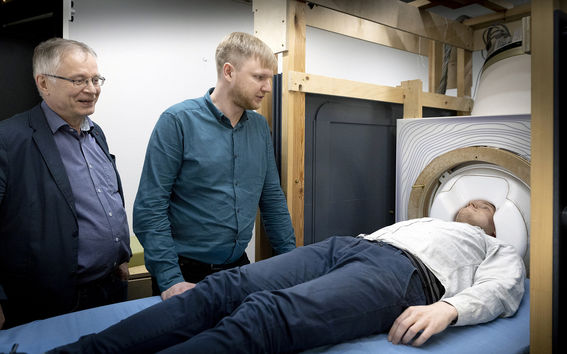New scanner can improve the detection of cancer tissue and brain disease diagnoses

A group of neuroscience and neurotechnology researchers have conducted extensive research and developed a new brain imaging technology in two EU projects led by Aalto University. As a result of the successful research, a new project funded by Business Finland just started with the aim of making the devices usable for patients. The project’s budget is one million euros.
“More accurate measurements can be helpful in locating epileptic brain activity before surgery. The new device is also expected to help distinguish brain tumours from healthy tissue more accurately prior to cancer surgery. In addition, the device will increase our understanding of the connections between the different brain regions. This will help us understand abnormal brain activity in connection with, for example, depression or the progress of Alzheimer’s disease”, explains Professor Risto Ilmoniemi, Head of Aalto University Department of Neuroscience and Biomedical Engineering.
The improved accuracy can also be useful in the study of stroke, autism and brain injuries; and especially as part of basic brain research.
The new device combines magnetoencephalography (MEG) and an unconventional type of magnetic resonance imaging (MRI). MEG uses sensors outside the head to measure the tiny magnetic fields produced in the brain, providing information about the functioning of the nervous system. MRI, meanwhile, is used for producing pictures of the brain’s structure. The combined device makes use of superconducting sensors called SQUIDs, developed by VTT Technical Research Centre of Finland. Superconductivity is also used in other parts of the technology. It is a quantum-mechanical phenomenon where the electrical resistance of a material abruptly disappears below a critical temperature.
The hybrid device enables the measuring of both the precise structure of the brain, and the magnetic fields that the brain generates. This produces a more reliable and accurate image of the brain activity.
Away from the confines of a noisy tube
Conventional magnetic resonance imaging is performed in a long, confined tube, and the machine makes very loud noises. The new technology enables a quiet and more open device structure—the patient lies on a bed equipped with a helmet-shaped slot for the head.
“This makes operations smoother and the measurement situation more natural. In addition, the device is also suitable for people of all sizes”, says Koos Zevenhoven, who leads the research group that develops the prototype’s instrumentation and methods.
The prototype has taken a wide range of research and development work, and it requires sensitive components that also must be compatible with each other.
The device contains liquid helium, in which the temperature is only four degrees above absolute zero, and the distance from the helium to the patient’s head is merely a couple of centimetres. Nevertheless, the patient experiences normal room temperature.
The biggest challenge is making the extremely sensitive magnetic field measurements while applying strong magnetic pulse sequences in magnetic resonance imaging. Everything needs to be designed to be as free of magnetic noise as possible so that the noise does not cover the measured signals.
“As the technology differs from conventional MRI in all its parts, we have had to design various new devices and solutions”, states Zevenhoven.
The goal of the new project is to bring the technology to a level that enables commercialisation and hospital deployment by the end of 2021.
Further information:
Risto Ilmoniemi
Professor
Aalto University
risto.ilmoniemi@aalto.fi
tel. +358 50 556 2964
Koos Zevenhoven
Research Group Leader
Aalto University
koos.zevenhoven@aalto.fi
tel. +358 40 752 8585
Read the previous news article on the topic at https://www.aalto.fi/en/news/breaking-through-barriers-for-a-revolution-in-brain-scans
Read more news

Your voice gives away valuable personal information, so how do you keep that data safe?
With speech technologies becoming increasingly common, researchers want to make sure we don’t give away more information than we mean to.
Deepika Yadav leverages technology to improve women's health
Deepika Yadav recently began as an assistant professor at the Department of Computer Science in the field of human-computer interaction (HCI) and interaction design for health and wellbeing.
A new way to measure contagion: the gut bacterium behind blood poisoning can spread like influenza
Neither the antibiotic-resistant nor the highly virulent strains are the most transmissible.






